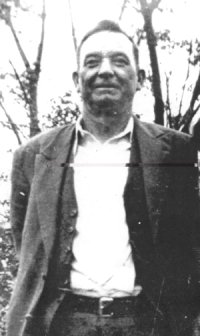Wreck of the Cotton Belt Extra 309 North
October 28, 1943
 When the Japanese bombed Pearl Harbor on Sunday, December 7, 1941, the fate of Cotton Belt Engineer Daniel Meyers Alexander was sealed. Alexander, then age 64, did not march off to war. But, he did decide to stay on with the “Gumboot Line” to “do his part” for the war effort despite being eligible for retirement from the St. Louis Southwestern Railway Company
(STLSW).
When the Japanese bombed Pearl Harbor on Sunday, December 7, 1941, the fate of Cotton Belt Engineer Daniel Meyers Alexander was sealed. Alexander, then age 64, did not march off to war. But, he did decide to stay on with the “Gumboot Line” to “do his part” for the war effort despite being eligible for retirement from the St. Louis Southwestern Railway Company
(STLSW).
[Click on photo for larger image]
Mr. Alexander had been employed by the STLSW since about 1920. He started as a fireman and quickly worked his way into an engineer position. In the 1930’s he ran the Malden, MO to Memphis, TN subdivision. By October 1943, Alexander was running the Extra 309 North from Hornersville, MO to Trumann, AR, with occasional trips south beyond Trumann to pickup freight cars. The Alexander family was living in Trumann.
On October 27, 1943, Alexander drove the 309, a 2-6-0, north from Trumann to Hornersville and tied up for the night. His daughter-in-law, Alfreda Rogers-Alexander, was aboard the caboose. Alfreda’s parents and siblings lived in Hornersville and she went for an overnight visit.
On the morning of October 28, 1943, Alfreda took her little brother, Chuck (age 11), to the Hornersville Depot to board the train heading back to Trumann. Engineer Alexander drove the train slowly south into Arkansas and at Trumann said goodbye to Alfreda and Chuck. It was the last time his family would see him alive.
Alexander continued south to pickup a freight car in McDonald, AR. On board Extra 309 North with Alexander were fireman Gene Harrington, a conductor and a brakeman. The 309 picked up the car and, with the engine moving backward, started the northbound return to Trumann, passing through McCormick, AR. Then, less than a mile north of McCormick, at 1:35 pm under a clear Arkansas sky, Extra 309 North derailed killing Alexander just three days after his 68th birthday. Fireman Gene Harrington was slightly injured as he jumped from the toppling engine.
The Interstate Commerce Commission’s investigation (number 2736, dated December 4, 1943) gives this account:
As the train was approaching the point where the accident occurred, the enginemen were maintaining a lookout ahead. The air brakes had functioned properly en route and the engine had been riding smoothly. The fireman said his first knowledge of anything being wrong was when he saw the tender sway and lurch to the left, and immediately afterward the tender was derailed to the right. It could not be determined when the engineer first became aware of anything being wrong, as he was killed in the accident. The conductor and the brakemen were in the caboose and their first knowledge of anything being wrong was when the derailment occurred. There was no defective condition of the engine prior to the accident, and there was no indication of dragging equipment, nor of any obstruction having been on the track.
The engine came to rest on its right side, pinning down engineer Alexander. This ended a long tradition of railroading in the Alexander family. D. M. Alexander’s father, Jake, had been a section hand for the Cotton Belt at Leachville, Arkansas. Descendents of the family now live in Florida.
|
Engineer D.M. Alexander |
Engine 309 while in service |
|

|

SSW 309 D-2
Rogers 1901
Click for larger image |
Ty Alexander
(D. M. Alexander’s grandson)
Sarasota, Florida
February 2001
RETURN to Famous Derailments
This page hosted by
 Get your own Free Home Page
Get your own Free Home Page
 When the Japanese bombed Pearl Harbor on Sunday, December 7, 1941, the fate of Cotton Belt Engineer Daniel Meyers Alexander was sealed. Alexander, then age 64, did not march off to war. But, he did decide to stay on with the “Gumboot Line” to “do his part” for the war effort despite being eligible for retirement from the St. Louis Southwestern Railway Company
(STLSW).
When the Japanese bombed Pearl Harbor on Sunday, December 7, 1941, the fate of Cotton Belt Engineer Daniel Meyers Alexander was sealed. Alexander, then age 64, did not march off to war. But, he did decide to stay on with the “Gumboot Line” to “do his part” for the war effort despite being eligible for retirement from the St. Louis Southwestern Railway Company
(STLSW).
